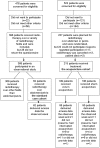Getting the grip on nonspecific treatment effects: emesis in patients randomized to acupuncture or sham compared to patients receiving standard care
- PMID: 21448267
- PMCID: PMC3063156
- DOI: 10.1371/journal.pone.0014766
Getting the grip on nonspecific treatment effects: emesis in patients randomized to acupuncture or sham compared to patients receiving standard care
Abstract
Background: It is not known whether or not delivering acupuncture triggers mechanisms cited as placebo and if acupuncture or sham reduces radiotherapy-induced emesis more than standard care.
Methodology/principal findings: Cancer patients receiving radiotherapy over abdominal/pelvic regions were randomized to verum (penetrating) acupuncture (n = 109; 99 provided data) in the alleged antiemetic acupuncture point PC6 or sham acupuncture (n = 106; 101 provided data) performed with a telescopic non-penetrating needle at a sham point 2-3 times/week during the whole radiotherapy period. The acupuncture cohort was compared to a reference cohort receiving standard care (n = 62; 62 provided data). The occurrence of emesis in each group was compared after a mean dose of 27 Gray. Nausea and vomiting were experienced during the preceding week by 37 and 8% in the verum acupuncture group, 38 and 7% in the sham acupuncture group and 63 and 15% in the standard care group, respectively. The lower occurrence of nausea in the acupuncture cohort (verum and sham) compared to patients receiving standard care (37% versus 63%, relative risk (RR) 0.6, 95 % confidence interval (CI) 0.5-0.8) was also true after adjustment for potential confounding factors for nausea (RR 0.8, CI 0.6 to 0.9). Nausea intensity was lower in the acupuncture cohort (78% no nausea, 13% a little, 8% moderate, 1% much) compared to the standard care cohort (52% no nausea, 32% a little, 15% moderate, 2% much) (p = 0.002). The acupuncture cohort expected antiemetic effects from their treatment (95%). Patients who expected nausea had increased risk for nausea compared to patients who expected low risk for nausea (RR 1.6; Cl 1.2-2.4).
Conclusions/significance: Patients treated with verum or sham acupuncture experienced less nausea and vomiting compared to patients receiving standard care, possibly through a general care effect or due to the high level of patient expectancy.
Trial registration: ClinicalTrials.gov NCT00621660.
Conflict of interest statement
Figures



References
-
- Enblom A, Bergius Axelsson B, Steineck G, Hammar M, Börjeson S. One third of patients with radiotherapy-induced nausea consider their antiemetic treatment insufficient. Support Care Cancer. 2009;17:23–32. - PubMed
-
- Lu W. Acupuncture for side effects of chemoradiation therapy in cancer patients. Seminars in oncology nursing. 2005;21:190–195. - PubMed
-
- IGARR (the Italian Group for Antiemetic Research in Radiotherapy) Radiation-induced emesis: a prospective observational multicenter Italian trial. Int J Radiat Oncol Biol Phys. 1999;44:619–625. - PubMed
-
- Mystakidou K, Katsouda E, Linou A, Parpa E, Kouloulias V, et al. Prophylactic tropisetron versus rescue tropisetron in fractionated radiotherapy to moderate or high emetogenic areas: a prospective randomized open label study in cancer patients. Med Oncol. 2006;23:251–262. - PubMed
-
- Feyer PC, Maranzano E, Molassiotis A, Roila F, Clark-Snow RA, et al. Radiotherapy-induced nausea and vomiting (RINV): MASCC/ESMO guideline for antiemetics in radiotherapy: update 2009. Support Care Cancer. In press. Available: http://www.ncbi.nlm.nih.gov/pubmed/20697746. Accessed 2010 Aug 10. - PubMed
Publication types
MeSH terms
Associated data
LinkOut - more resources
Full Text Sources
Medical

